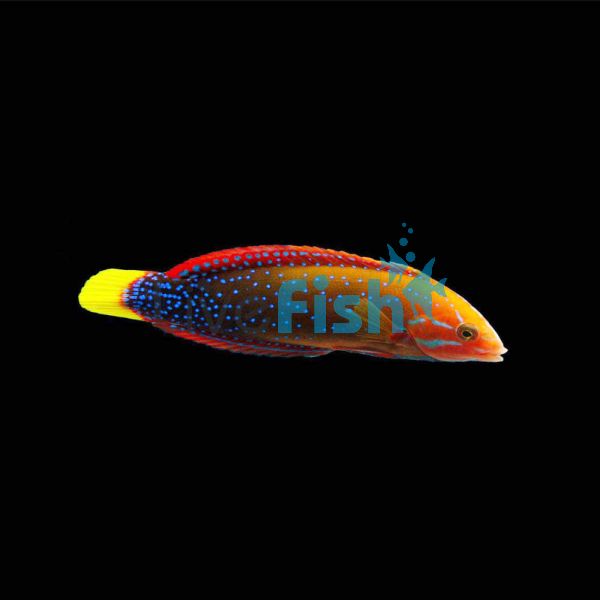Yellowtail Coris Wrasse - Medium Juvenile
Medium size with juvenile colouration.
The Yellow Tail Coris is one of those amazing species of wrasse that will change dramatically from juvenile to adulthood. Don't worry though, both the young and old are equally as stunning as each other!
The juveniles of this species start off their lives with a vibrant neon orange colouring with white tiger stripes running down its body which are outlined in black. It is thought that this colouration deters predators who mistake them for other more toxic species of fish. Once fully grown the adults will slowly lose the stripes and their body will turn a greenish shade of blue with neon blue dots scattered it all over. Their face will develop horizontal green lines and their tail will change into the distinctive yellow colour from which they get their name.
Once fully grown the males can be distinguished from the females by the presence of a light green stripe just above its anal fin. Recently there has been some success and a small number of these fish have been born and raised in captivity, but it is extremely rare and difficult to do so.
This extremely popular fish is sure to brighten up your tank as it loves to spend all day swimming around in open areas and hunting for food. During the night it will bury itself in the sand and wake up every morning at exactly the same time. Don't be shocked if it stays buried the first few days of being introduced to your tank. This is normal and they will soon start to feel at home and come out to play.
This species of wrasse are seen all around the Indian - West Pacific region ranging from Japan and Hawaii all the way over through Australia and to the Christmas Islands. They will spend their lives around sandy coral and rubbles zones of reefs and lagoons and have been spotted at depths down to 45 metres.
Tank Recommendations for Yellowtail Coris Wrasse Juvenile
The smallest tank size for this species is 570 litres. They look cute and small when young but believe us when we say they can quickly grow big and will need a lot of space for its active lifestyle. Yellowtail Coris Wrasse will bury themselves in the sand when juvenile and as such, you should be sure to provide a fine sand bed (largest 2mm) of about 12cm deep. Also, include plenty of caves and crevices so they can hunt but do not obstruct open swimming areas. These fish will actively move around pieces of coral in search of food and also dive into the sand bed when startled, both of which will cause sand particles to be dispersed around the water which will settle and damage corals. For this reason, we recommend keeping them in a fish only aquarium setup.
Suitable Tank Buddies
These fish should be kept with larger more aggressive species that will not be easily bullied. Slow-moving fish will not be able to compete with the wrasse come feeding time. Only one adult male should be kept in the tank at the same time as they will fight to establish dominance.
Usually Compatible
Tangs and damsels would be great options to combine with this species. Other good choices for tank buddies could include Boxfish and large fully grown species of Angelfish.
Sometime Compatible
Dwarf Angelfish, Butterflyfish, Cardinalfish and Clownfish should be observed to make sure they are allowed to feed. Other species to keep an eye on if keeping with the Yellow Coris Wrasse are Pufferfish, Parrotfish, Groupers and Eels.
Rarely Compatible
Batfish should not even be considered along with Seahorses and Pipefish. These species are too slow and will probably starve to death in the presence of this fish. Invertebrates and crustaceans will get preyed upon and eaten whereas a Shark will actively hunt the wrasse.
Feeding your Yellowtail Coris Wrasse
These fish are a carnivorous species and in the wild will hunt for smaller fish, invertebrates, crustaceans and worms. You should provide it with a varied meat diet which can include mysis and brine shrimp mixed with any frozen marine-based preparation. Live food can also be offered. Try to feed them 2 times a day and with time they can learn to accept marine flake and pellet food.
| Scientific Name | Coris gaimard |
|---|---|
| Care Level | Moderate |
| Common Names | The Yellowtail Coris Wrasse is also known as Red Coris and the Clown Wrasse |
| Diet | Carnivore |
| Fish Family | Labridae |
| Lifespan (years) | 7 |
| Max. Length (cm) | 41 |
| Min. Tank Volume (l) | 570 |
| Origin | Indo-Pacific |
| Reef Safe | No |
| Sociability | Semi-aggressive |
| Venomous | No |
| Water Conditions | 22-27° C, dKH 8-12, pH 8.0-8.5, sg 1.020-1.026 |




